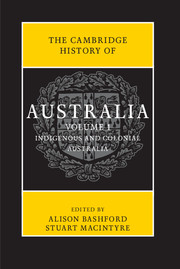Book contents
- Frontmatter
- Contents
- Abbreviations
- List of maps
- List of figures
- List of tables
- Notes on contributors
- Map
- Preface
- Introduction
- PART I
- PART II
- Further reading
- Chronology
- Index
- Frontmatter
- Contents
- Abbreviations
- List of maps
- List of figures
- List of tables
- Notes on contributors
- Map
- Preface
- Introduction
- PART I
- PART II
- 9 Religion
- 10 Culture and media
- 11 Science and medicine
- 12 Society and welfare
- 13 Gender and sexuality
- 14 Indigenous Australia
- 15 Class
- 16 The economy
- 17 Government, law and citizenship
- 18 Education
- 19 The environment
- 20 Travel and connections
- 21 Security
- 22 Australia, Britain and the British Commonwealth
- 23 Australia in the Asia-Pacfic region
- 24 The history anxiety
- Further reading
- Chronology
- Index
22 - Australia, Britain and the British Commonwealth
from PART II
Published online by Cambridge University Press: 05 November 2013
- Frontmatter
- Contents
- Abbreviations
- List of maps
- List of figures
- List of tables
- Notes on contributors
- Map
- Preface
- Introduction
- PART I
- PART II
- Further reading
- Chronology
- Index
- Frontmatter
- Contents
- Abbreviations
- List of maps
- List of figures
- List of tables
- Notes on contributors
- Map
- Preface
- Introduction
- PART I
- PART II
- 9 Religion
- 10 Culture and media
- 11 Science and medicine
- 12 Society and welfare
- 13 Gender and sexuality
- 14 Indigenous Australia
- 15 Class
- 16 The economy
- 17 Government, law and citizenship
- 18 Education
- 19 The environment
- 20 Travel and connections
- 21 Security
- 22 Australia, Britain and the British Commonwealth
- 23 Australia in the Asia-Pacfic region
- 24 The history anxiety
- Further reading
- Chronology
- Index
Summary
Australia's relationship with Britain and the ‘British’ Commonwealth (the ‘British’ was dropped in 1965) changed fundamentally, if gradually, across the twentieth century. In 1901 Australia was an integral, though self-governing, part of the British Empire, variously called a ‘colony of settlement’ or a ‘dominion’. This reflected the fact that the population, overwhelmingly immigrants or descended from immigrant parents or grandparents, regarded themselves as transplanted Britons. The relationship with the ‘mother country’ was complex and intimate. In the 1960s and 1970s this relationship, which had been attenuating for decades, unravelled with astonishing speed. Britain shed its empire and retreated into Europe. Immigration patterns changed and changed again. So did trade. The Empire became the Commonwealth – a voluntary international organisation of mostly small, nearly all British-influenced developing countries in Africa, Asia, the Pacific and the Caribbean – and for Australia one of a number of useful platforms for dealing with global and regional issues. Curiously, bonds with Britain remain close, as many values, institutions and interests are shared. Nonetheless, the dependent relationship has long gone, replaced by occasional co-participation under American leadership in military ‘coalitions of the willing’.
Independent Australian Britons
Alfred Deakin, Australia's most eminent prime minister in the early Federation years, and a closet correspondent for the London Morning Post, summed up the zeitgeist of that time by characterising himself and his fellow Australians as ‘independent Australian Britons’. In the decade after 1901 some 400,000 Britons migrated to Australia to join a population that was, as it boasted, ‘98 per cent’ British, most of them the children or grandchildren of British immigrants. This was the ‘crimson thread of kinship’ of which that other Federation father, Sir Henry Parkes, had spoken. What is more, blood was backed by iron – in the form of the Royal Navy, which acted as Australia's primary defensive shield – and treasure – in the form of British investment, which oiled the wheels of Australia's commerce. Over half of the country's imports and exports came from and were sent to Britain; trade with the rest of the Empire was far less significant.
- Type
- Chapter
- Information
- The Cambridge History of Australia , pp. 518 - 536Publisher: Cambridge University PressPrint publication year: 2013
- 5
- Cited by



